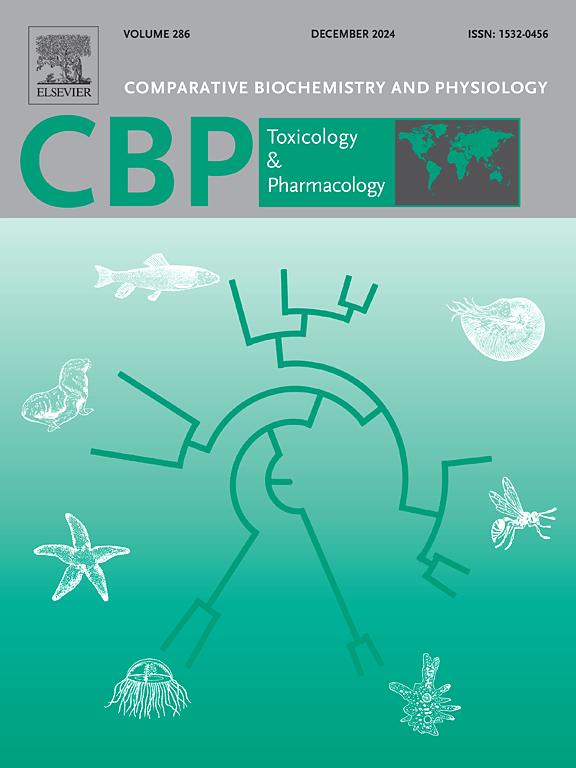6PPD impairs growth performance by inducing intestinal oxidative stress and ferroptosis in zebrafish
IF 3.9
3区 环境科学与生态学
Q2 BIOCHEMISTRY & MOLECULAR BIOLOGY
Comparative Biochemistry and Physiology C-toxicology & Pharmacology
Pub Date : 2025-02-21
DOI:10.1016/j.cbpc.2025.110161
引用次数: 0
Abstract
N-(1,3-dimethylbutyl)-N'-phenyl-p-phenylenediamine (6PPD), a tire-derived pollutant, has gained increasing attention due to its potential toxicity to aquatic organisms. Although previous studies have revealed that 6PPD impacts early developmental stages of larval fish, its effects on adult fish, particularly on key organs, remain unclear. In this study, we observed that adult zebrafish exposed to 6PPD exhibited reduced growth performance and increased fecal output. Histological examination with hematoxylin and eosin (H&E) staining revealed damage to the intestinal villi and a reduction in goblet cell numbers, indicating that 6PPD impairs growth performance by disrupting the digestive system. Comparative transcriptomic analysis revealed that 6PPD caused significant changes in the expression of 727 genes in the intestine, of which 280 genes were up-regulated and 447 genes were down-regulated. These genes were primarily associated with nutrient digestion and absorption, energy metabolism, immune response, and redox regulation. Mechanistically, 6PPD induced oxidative stress and triggered ferroptosis in the intestine, leading to structural damage of the intestinal villi. Treatment with the antioxidant N-acetylcysteine (NAC) alleviated 6PPD-induced oxidative stress and ferroptosis, thereby improving intestinal villi structure and promoting fish growth. This study provides insights into the mechanisms by which 6PPD impairs growth in adult zebrafish and highlights NAC as a potential therapeutic strategy to mitigate its toxicity.

ppd通过诱导斑马鱼肠道氧化应激和铁下垂损害生长性能。
N-(1,3-二甲基丁基)-N'-苯基-对苯二胺(6PPD)是一种轮胎衍生的污染物,因其对水生生物的潜在毒性而越来越受到人们的关注。尽管先前的研究表明6PPD会影响幼鱼的早期发育阶段,但其对成年鱼的影响,特别是对关键器官的影响尚不清楚。在本研究中,我们观察到暴露于6PPD的成年斑马鱼表现出生长性能下降和粪便排出量增加。苏木精和伊红(H&E)染色的组织学检查显示肠绒毛受损,杯状细胞数量减少,表明6PPD通过破坏消化系统来损害生长性能。对比转录组学分析显示,6PPD导致肠道中727个基因的表达发生显著变化,其中280个基因表达上调,447个基因表达下调。这些基因主要与营养物质的消化和吸收、能量代谢、免疫反应和氧化还原调节有关。在机制上,6PPD诱导氧化应激,引发肠道铁下垂,导致肠绒毛结构损伤。抗氧化剂n -乙酰半胱氨酸(NAC)可缓解6ppd诱导的氧化应激和铁下垂,从而改善肠绒毛结构,促进鱼类生长。该研究提供了6PPD损害成年斑马鱼生长的机制,并强调NAC是减轻其毒性的潜在治疗策略。
本文章由计算机程序翻译,如有差异,请以英文原文为准。
求助全文
约1分钟内获得全文
求助全文
来源期刊
CiteScore
7.50
自引率
5.10%
发文量
206
审稿时长
30 days
期刊介绍:
Part C: Toxicology and Pharmacology. This journal is concerned with chemical and drug action at different levels of organization, biotransformation of xenobiotics, mechanisms of toxicity, including reactive oxygen species and carcinogenesis, endocrine disruptors, natural products chemistry, and signal transduction with a molecular approach to these fields.

 求助内容:
求助内容: 应助结果提醒方式:
应助结果提醒方式:


